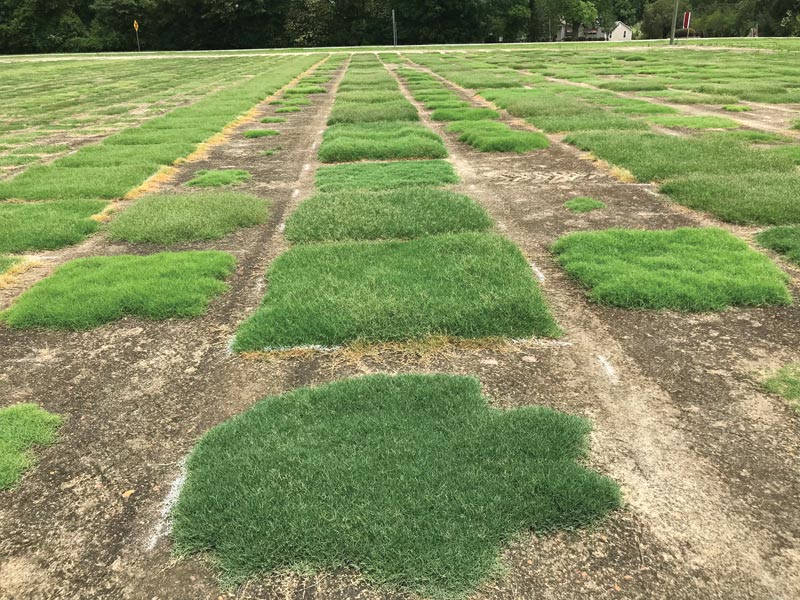
Figure 1. Evaluation in 2018 of new experimental triploid interspecific hybrid bermudagrasses at the University of Georgia campus in Tifton, Ga. Photo by Brian Schwartz
A hybrid is a cross between two genetically different plants. Hybrid plants that were deliberately developed by humans — as opposed to occurring naturally in the wild — first made a significant impact on society when development of superior hybrid corn varieties during the first half of the 20th century led to a spike in corn production that has continued to the present day.
Just as improvements in corn revolutionized farming and the American diet, genetic improvements in turfgrasses have significantly altered and enhanced golf course management practices. For many years, the turfgrass breeding program at the University of Georgia’s facility in Tifton, Ga., has focused on developing superior bermudagrasses for turf and for forage (Figure 1, above). In this article, we present some basic information about bermudagrass hybrids and the work that has been done at the University of Georgia.
Hybrid bermudagrass biology
Usually, better hybrids result from crossing more genetically diverse parents. Whether a hybrid is better than a non-hybrid in a specific plant species depends to a large degree on the genetic makeup of the parents of the hybrid. Consequently, just making crosses is no assurance of developing superior hybrids. The production of thousands of experimental hybrids may result in only a single superior hybrid (3).
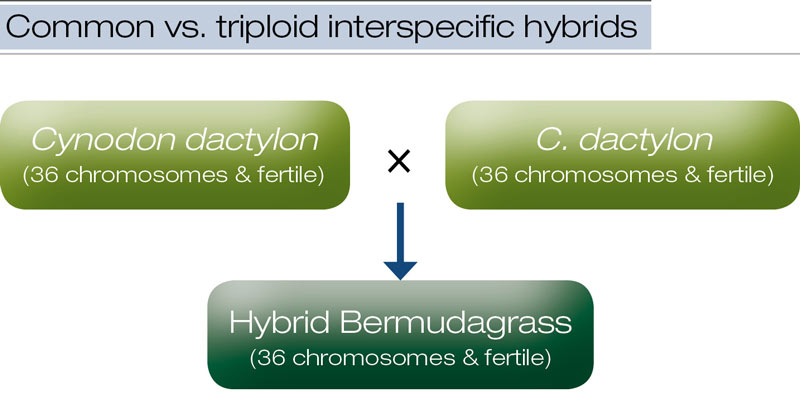
Figure 2. Production of common hybrid bermudagrass.
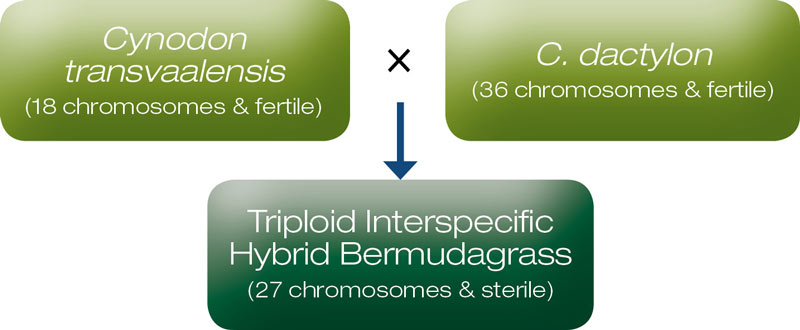
Figure 3. Production of triploid interspecific hybrid bermudagrass.
Because bermudagrass is a sexual species with perfect flowers (male and female organs in the same flower), it can set seed through two mechanisms or a combination of these mechanisms. Bermudagrass plants can be either self-fertile or self-incompatible. In self-fertile plants, pollen from a flower on a plant can fertilize the female organs (stigmas) on the same plant and produce seed.
When plants are self-incompatible, pollen from a flower on a plant cannot fertilize the stigmas (pollen will not grow properly on the stigma) on the same plant to produce seed. To set seed, self-incompatible plants need to be fertilized by pollen from genetically different plants nearby. Many grasses, including bermudagrass, have various degrees of self-fertility or self-incompatibility. Self-incompatibility is controlled by several genetic and environmental mechanisms (2,3).
Crosses can be made within a species, and resulting plants are usually referred to as hybrids. Crosses between species of a particular genus are interspecific hybrids. The purpose of this manuscript is to clarify the difference between a hybrid (Figure 2) and a triploid interspecific hybrid (Figure 3) in the bermudagrass genus.
Common vs. hybrid bermudagrass
Vegetative propagation
Common bermudagrass (Cynodon dactylon) is predominantly tetraploid (2n = 4x = 36 chromosomes) and produces outcrossed seed because of various levels of self-incompatibility (4). Because of this self-incompatibility, a large portion of the bermudagrass plant populations around the world consists of natural hybrids. Depending on the genetic makeup of the parents, some of the natural hybrids can be better than other plants in the immediate population. Improved plants are sometimes selected from these populations. Plants with improved and/or desirable plant characteristics can be marketed as commercial cultivars.
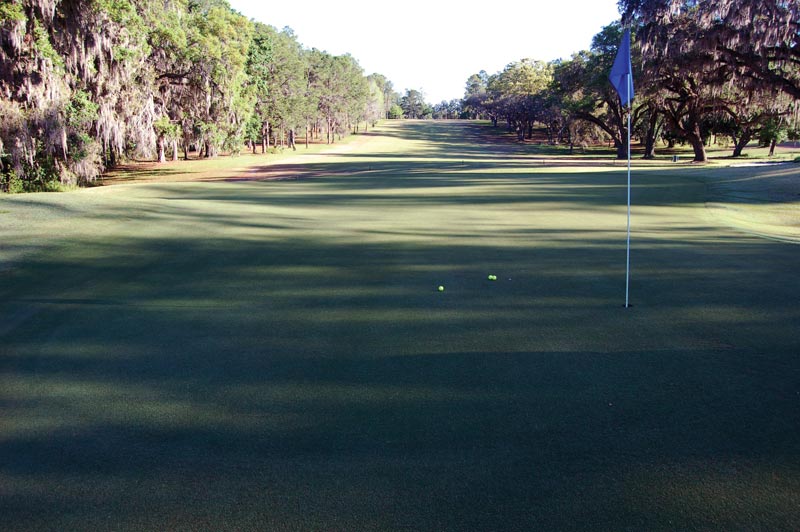
Figure 4. Pollen- and seed-sterile interspecific hybrid bermudagrasses are much easier to maintain than hybrids of common bermudagrasses, no matter whether they are in an athletic field, golf course, home lawn or landscaped area. Photo by Wayne Hanna
Turf and forage bermudagrass breeding programs usually focus on producing hybrids. University of Georgia programs have produced hybrid cultivars, such as Coastal and Tifton 85 forage bermudagrasses, that were superior hybrid plants selected from thousands of experimental hybrids produced by selecting, developing and crossing outstanding parents.
Examples of vegetatively propagated turfgrass hybrid bermudagrass cultivars are Tiflawn (a product of intentional crosses of superior parents), VaMont, Celebration and Tifton 10 (a fertile hexaploid with 54 chromosomes) bermudagrasses, which were selected from natural populations. Their identity is maintained through vegetative propagation of rhizomes, stolons and/or stems (1).
These hybrid cultivars have various levels of seed production potential from selfing, and from crossing, if pollen is available from different bermudagrass plants in the surrounding area. The seed production by these cultivars can easily produce off-types that can contaminate the purity of the planted cultivar. Although they are hybrids, these cultivars are technically common bermudagrasses with improved characteristics that are maintained by vegetative propagation (4).
The released common bermudagrass forage and turf hybrids have made important contributions to animal nutrition and improved landscapes (1). However, it should be remembered that common bermudagrass, especially C. dactylon, can produce deep rhizomes that are difficult to control and seed that is easily dispersed. These two characteristics can make these hybrid cultivars invasive in certain situations.
Bermudagrass seed propagation
Other bermudagrass breeding programs develop and select highly self-incompatible superior genotypes and use these selections to produce two-parent or multi-parent hybrid seed for commercial sale. Most of the seed is hybrid, because a parent will not typically produce seed from its own pollen; rather, seed is produced when crossed with pollen from other parents in the population.
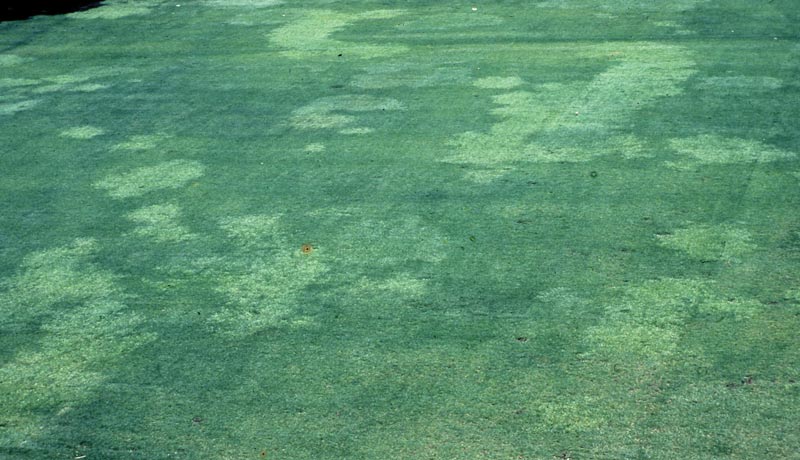
Figure 5. Common bermudagrasses are self-incompatible and can produce seed and pollen, which means they can produce natural hybrids within an area such as a lawn or fairway. The result may be an unattractive turfgrass mosaic. Photo by Wayne Hanna
These hybrid cultivars usually consist of a population of hybrids, because the number of cross combinations increases as the number of parents and/or as the genetic diversity of each parent increases, and because most bermudagrass parents are heterozygous and not pure inbreds, as in corn and other crops (3).
Commercial seed must be harvested from the fields with the parental combination each year. The identity of the original hybrid is lost if seed is harvested from subsequent generations of the hybrid. The two- or multi-parent hybrids are still tetraploid common bermudagrass, but with desirable improved traits. Private companies usually do not reveal the identity of the parents and/or parental combinations. Numerous seed-propagated bermudagrass turf cultivars are now available, including Princess 77, Riviera and Yukon.
Triploid interspecific hybrid bermudagrass
Most high-quality commercial interspecific hybrids in bermudagrass are a cross between two distinct Cynodon species: C. transvaalensis (2n = 2x = 18 chromosomes) and C. dactylon (2n = 4x = 36 chromosomes). The hybrids from these crosses have 2n = 3x = 27 chromosomes and are triploid interspecific hybrids that produce no pollen and no seed (2).
Just as the mule born of a donkey × horse cross is sterile and cannot produce progeny, these bermudagrass triploid interspecific hybrids are pollen-sterile and seed-sterile. The sterility in interspecific hybrid bermudagrasses is also similar to the sterility in seedless watermelons, grapes and bananas.

Figure 6. Anthers in flowers of bermudagrass. Anthers of common hybrid bermudagrass (left) dehisce (open to spread pollen), but the spongy anthers of triploid interspecific hybrid (right) remain closed and do not dehisce. Photo by Wayne Hanna
Examples of triploid interspecific hybrid bermudagrasses that have improved athletic and landscape turf around the world are Tifgreen, Tifdwarf, Tifway, TifSport, TifEagle, TifGrand and TifTuf from the University of Georgia, and Latitude 36 from Oklahoma State University. Selected from thousands of man-made crosses of superior parents (2), these hybrids incorporate the fineness of C. transvaalensis with the toughness of C. dactylon. They are propagated vegetatively by stems, stolons and shallow rhizomes (Figure 4) (1).
Major differences exist between hybrid and triploid interspecific hybrid bermudagrass cultivars. When people refer to the high quality of hybrid bermudagrasses in turf, most are referring to the triploid interspecific hybrids. Common hybrid bermudagrass cultivars have one or more desirable characteristics, such as better color, cold tolerance, close mowing tolerance, etc. However, common hybrid bermudagrass cultivars have the potential for producing pollen and seed, which, over time, can produce turf with a mosaic pattern (Figure 5).
In addition, the common hybrids have deep rhizomes that can be invasive and are difficult to eradicate if the grass is being replaced. In comparison, triploid interspecific hybrid bermudagrass cultivars do not produce seed or pollen (Figure 6), and their rhizomes are shallow, which makes them easier to manage and prevents them from being invasive.
How easy is it to distinguish between a hybrid and an interspecific hybrid? Common hybrid bermudagrass is usually coarser and produces lower-quality turf than interspecific bermudagrass hybrids. A relative trait comparison of the two types of bermudagrasses is summarized in Table 1 and Figure 7, below. However, this comparison is relative and may not be the most reliable identifier.
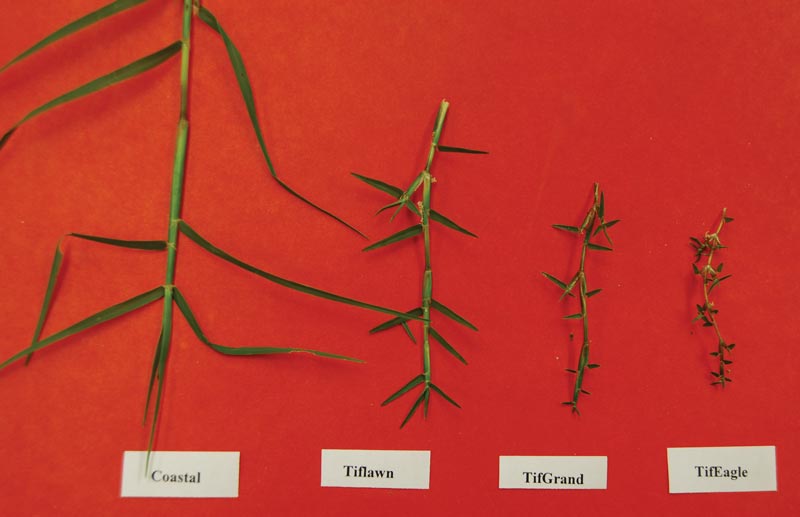
Figure 7. Four of the bermudagrasses produced by the University of Georgia from 1943 through 1998 (from left): Coastal, a hybrid forage cultivar, was introduced in 1942; Tiflawn, a 36-chromosome vegetatively propagated hybrid suitable for sports fields and playgrounds, was introduced in 1952; TifGrand, the first sterile and shade-tolerant (up to 50% shade) triploid interspecific hybrid bermudagrass, was introduced in 2009; and TifEagle, a triploid interspecific hybrid developed for golf course use, was introduced in 1997. Photo by Wayne Hanna
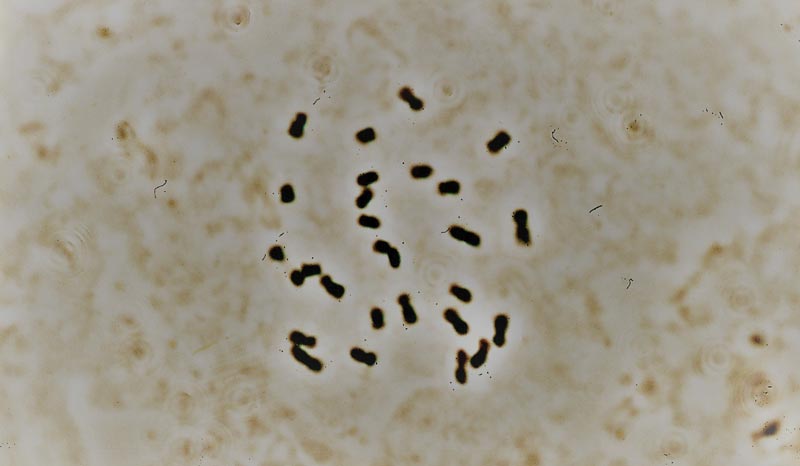
Figure 8. The best means of distinguishing between a hybrid bermudagrass and an interspecific hybrid is to count the chromosomes. This task is best carried out by the developer of the cultivar. Triploid interspecific hybrids usually have 2n = 27 chromosomes (shown above), and common hybrids usually have 2n = 36 chromosomes. Photo by Wayne Hanna
The best technique is to count the chromosomes of the cultivar, which needs to be done scientifically and should be the responsibility of the developer of the cultivar. The oldest and most precise method is to count the chromosomes (Figure 8) in root tips of the cultivar, but many laboratories do not use this technique any longer. Today, most laboratories use a flow cytometer to measure the quantity of DNA in cells. This technique is reliable, but one has to have a reliable control bermudagrass cultivar with a known chromosome number to serve as the standard. Triploid interspecific hybrids usually have 2n = 27 chromosomes. Common hybrids usually have 2n = 36 chromosomes (4).
Hybrid bermudagrass: The last word
The information presented in this article stems from approximately 50 years of research, experience and long-term observations on the way things have worked out over time. Budgets, costs, availability, environmental challenges and the desired method of planting — seed vs. sod or sprigs — will all affect cultivar choice.
As new hybrid and triploid interspecific hybrid bermudagrasses are developed in the future, we hope this commentary will help the purchaser evaluate the positive and negative attributes of each type of bermudagrass. Consumers should specifically ask whether a cultivar is a hybrid or a triploid interspecific hybrid, and should expect to receive a clear answer.
The research says ...
- Common bermudagrass produces various levels of outcrossed seed because of self-incompatibility, which means that many bermudagrass populations are composed of natural hybrids. Plant breeders extend the breeding process to further improve these natural crosses.
- Some breeding programs develop superior hybrids from thousands of crosses, which are propagated vegetatively and sold as sod or sprigs.
- Programs that develop and select self-incompatible genotypes produce hybrid seed from two or more parents; seed is harvested from fields planted with the same parental combination each year to maintain the original hybrid.
- Triploid interspecific hybrids are considered higher-quality bermudagrass turf, whereas hybrids of common bermudagrass have the potential to produce seed and have deep rhizomes, which are difficult to eradicate.
- In general, consumers looking for turf for golf courses, lawns, landscaping and sports turf should look for improved triploid interspecific hybrids.
Literature cited
- Hanna, W.W., and W. Anderson. 2008. Development and impact of vegetative propagation in forage and turf bermudagrasses. Celebrate the Centennial (A Supplement to Agronomy Journal). S-103-S-107.
- Hanna, W.W., B.L. Burson and B.M. Schwartz. 2016. Polyploidy and interspecific hybridization in Cynodon, Paspalum, Pennisetum, and Zoysia. Pages 318-338. In: A.S. Mason, ed. Polyploidy and Hybridization for Crop Improvement. CRC Press, Boca Raton, Fla. doi:10.1201/9781315369259-13
- Hanna, W., P. Raymer and B. Schwartz. 2013. Warm-season grasses: biology and breeding. Pages 54-590. In: J. Stier, B. Horgan and S. Bonos, eds. Turfgrass: Biology, Use, and Management. Agronomy Monograph No. 56. ASA, CSSA and SSSA, Madison, Wis.
- Taliaferro, C.M. 2003. Bermudagrass. Pages 235-256. In: M.D. Casler and R.R. Duncan, eds. Turfgrass Biology, Genetics and Breeding. John Wiley & Sons, Hoboken, N.J.
Wayne W. Hanna is a professor and Brian M. Schwartz is an associate professor in crop and soil sciences at the Institute of Plant Breeding, Genetics and Genomics at the University of Georgia campus in Tifton, Ga.